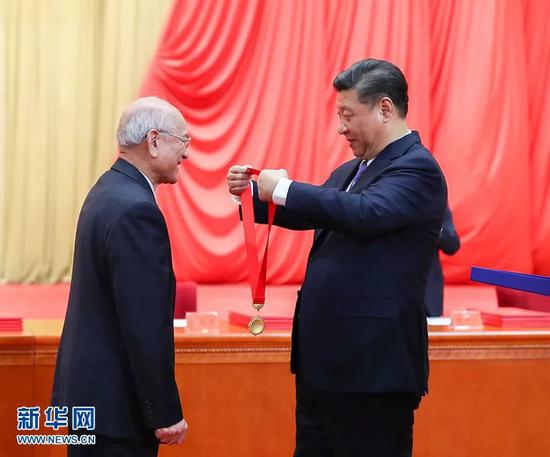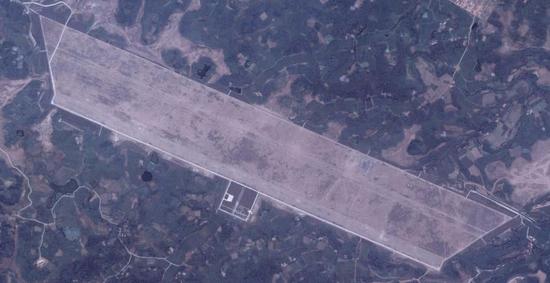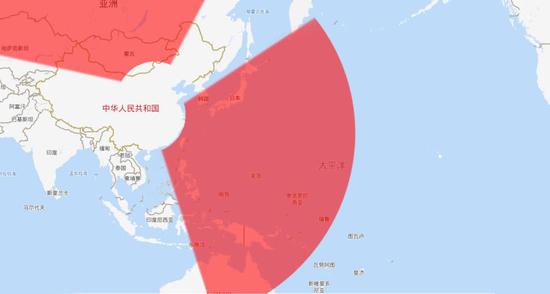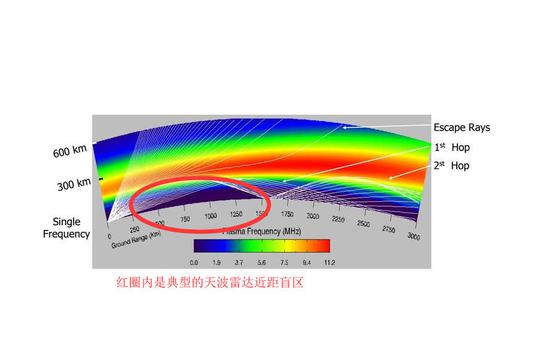One of the many Chinese Radar kings! The other kings includes Laser Lidar; Quantum Radars; Terahertz Radars; VHF; Passive Radars... all can see so called Stealth. This one see the furthest better than high altitude AWACs. From China can see Australia!
http://news.sina.com.cn/c/2019-01-14/doc-ihqfskcn7054368.shtml
为什么中国雷达专家能拿800万奖金?俄媒这样说
为什么中国雷达专家能拿800万奖金?俄媒这样说
30,730
原标题:聚焦 | 俄媒:为什么中国雷达专家能拿800万奖金?
俄罗斯卫星网1月12日发表题为《中国科学家因何获得800万奖金?》的报道称,1月8日,哈尔滨工业大学教授刘永坦荣获2018年度国家最高科学技术奖,同时获得800万人民币的奖金。超视距雷达是刘永坦领导下的专家们所取得的关键性研发成果之一。俄罗斯军事专家瓦西里·卡申发表文章就中国超视距雷达所取得的成绩做了解读,以期揭开刘永坦因何获得800万奖金的“秘密”。现将全文摘编如下:
 ▲1月8日,2018年度国家科学技术奖励大会在北京人民大会堂隆重举行。这是中共中央总书记、国家主席、中央军委主席习近平向获得2018年度国家最高科学技术奖的哈尔滨工业大学刘永坦院士颁发奖章。 新华社记者 谢环驰 摄
▲1月8日,2018年度国家科学技术奖励大会在北京人民大会堂隆重举行。这是中共中央总书记、国家主席、中央军委主席习近平向获得2018年度国家最高科学技术奖的哈尔滨工业大学刘永坦院士颁发奖章。 新华社记者 谢环驰 摄
中国正努力研究海基机动超视距雷达,并希望凭此提升在西太平洋地区针对美军的反介入战力。
无线电信号为直线传播,甚至功率最大的常规陆基雷达也无法看到百公里外超低空飞行目标。预警机因尺寸和功率限制仅能部分解决这个问题。
超视距雷达的工作原理是借助无线电波在电离层的反射或折射效果。由于它不受地球曲率的限制,故而没有常规雷达的局限性,但要真正实现超视距,则需要付出高昂代价。此类雷达在技术上极其复杂且非常昂贵,由大量中转和接收天线组成,有时彼此之间相距数百公里。
早在上世纪60年代末,中国已开始研发这种雷达,与苏联和美国几乎同时。苏联和美国在冷战结束前已经建成首批可实际运行的雷达样机,但中国项目因技术基础薄弱而未能取得成功。
解放军列装的首批超视距雷达是俄产的“向日葵-E”型雷达。中国于2000年初从俄罗斯购买了3套。“向日葵”系列是相对较小的海军超视距雷达。中国购买的型号可发现接近300公里外的水面目标。2000年代,俄罗斯海军也购买了此款雷达,部署在里海和太平洋。
2008年,中国在其北部地区建成更大型的超视距雷达,为空军所用,是导弹预警系统中的一部分。据西方评估,其预警距离可达2500公里。此后,中国继续加大投入发展海军超视距雷达系统,并为战略防空和反导用途制造功率更强的雷达。
中方的研发过程与俄罗斯强化此项工作是同步进行的。2002年,俄罗斯建成“集装箱”超视距雷达,其预警距离是3000公里,扫描范围是240度。之后经过长时间的调整和测试,2013年开始在军队中运行。
 ▲俄罗斯卫星网相关报道截图
▲俄罗斯卫星网相关报道截图
这种可同时发现5000个目标的巨型设施据称将在2019年进入全面战斗值班状态。与此同时,俄罗斯还在发展“向日葵”海上雷达网络。俄罗斯将在自己周边地区建成功率强大的雷达侦测系统,可针对空中和海上攻击预警。目前还不清楚俄罗斯是否有建设海基机动超视距雷达计划,也许这与俄罗斯水面舰队规模不大有关。苏联解体之后,俄罗斯主要建造的是中小型舰艇(轻型护卫舰和巡逻舰)。
对于中国来说,建设海基超视距雷达是迫切的,且具有重要的意义。中国已在远距离海上攻击方面投入巨资,部署大量反舰弹道导弹、岸基重型反舰巡航导弹以及轰炸机。相应的,保障这些重型武器能在远距离发现和跟踪目标则成为必须要解决的问题。
众所周知,中国在侦察卫星集群以及重型侦察无人机等方面投入巨大。但是,这些手段中的任何单项,都无法获得可靠的效果,尤其在对手是美国的时候。而建设海上机动超视距雷达,是保障侦测远离中国海岸目标的重中之重。俄罗斯海军在演习中使用“向日葵”雷达,为反舰导弹指示目标位置,而中国海军看来也将使用同样的方式。
海上机动超视距雷达可为美国舰队在第一、第二岛链范围内的行动制造很多的困难。未来,中国航母战斗群还将提高在远海上的作战能力,而超视距雷达技术也可使其更快发现敌方在远距离发射的巡航导弹和派出的空中力量。

责任编辑:张岩
https://mil.news.sina.com.cn/jssd/2019-01-15/doc-ihqhqcis6315115.shtml
刘永坦一科研成果远胜地波雷达 反导预警覆盖地球一半
刘永坦一科研成果远胜地波雷达 反导预警覆盖地球一半
4
要说近段时间来,在军迷圈里最热议的话题,那肯定是年初刚揭晓的2018年度国家最高科学技术奖。在荣膺该奖项并获得800万元奖金的两位“国士”中,著名的雷达专家刘永坦及其团队所研发的新体制雷达,备受关注。想必许多人在大奖揭晓之初,就根据相关介绍了解到了这个新体制雷达,所采用的是先进的“高频地波超视距”概念。即利用高频电磁波可以在海平面形成爬行波的特性,来实现对远程水面或低空目标的超视距探测,因此这个地波超视距雷达也被形象的称为“海疆千里眼”。

高频地波超视距雷达的获奖使其备受关注
绝大多数人都没注意到的是,刘永坦院士及其背后的团队所涉及的研究领域,可远不局限于此。根据相关资料显示,他所领衔的这个团队,同样负责了国产天波超视距雷达项目的研究。而从某种程度上讲,这个被称为天波超视距雷达的东西,要比此次获奖中被着重宣传的地波超视距雷达更为的“黑科技”。之所以这样说,主要是因为天波超视距雷达它那近乎能将半个地球尽收眼底的恐怖探测距离,毫无疑问在战略层面上的作用更为突出,无论是弹道导弹预警还是反隐身轰炸机,都算得上这类雷达的拿手好戏。

刘永坦团队还涉及了功能更为强大的天波超视距雷达项目

国产天波超视距雷达的主要探测方向和覆盖范围
天波超视距雷达与地波超视距雷达一样,都是把可以无视地球曲率探测到地/海平线下目标的能力当成主要卖点。但实际上,这两者之间实现超视距探测所依靠的原理却有着较大的区别。相比前面提到的,主要依靠海平面爬行波特性的地波超视距雷达。同样工作在高频波段的天波超视距雷达,其所利用的则是高频波段电磁波会在电离层与地面之间形成反射的特点,来克服地球曲率以实现对超远距离外目标的超视距探测。也正是因为如此,天波超视距的作用距离一般都能达到地波超视距的十倍以上,即4000-5000公里级别。

天波雷达实现超视距功能的原理如图所示
如此恐怖的探测距离,自然让天波超视距雷达被赋予了独一无二的战略意义。对潜射巡航导弹乃至弹道导弹,以及试图依靠地球曲率进行突防的轰炸机群等目标,天波超视距都能做到十分良好的探测效果。因此,包括中美俄在内各个幅员辽阔的大国,均先后打造出了自己的天波超视距探测/预警体系,作为传统微波防空雷达探测网的补充。除此之外,由于高频波段动辄长达数十米以上的工作波长,更是使其误打误撞般的成为了一种反隐身利器。而随着各类武器平台的隐身化渐成趋势,天波超视距雷达的重要性反而越来越凸显。

随着隐身时代的到来,天波超视距雷达的重要性越发凸显
当然,世界上不会有尽善尽美的武器,我们的天波超视距雷达自然也不会例外。对于天波超视距雷达而言,它所依靠的电离层对高频电磁波的折射原理,也同样是其最大缺陷的源头。由于这类雷达的初始波束仰角巨大,因此波束在天线发射后经由电离层反射到地面时,会产生高达1000公里左右不能被探测到的近距盲区。以我国面向太平洋战略方向的天波超视距雷达为例,其庞大的收发天线就部署在离东部海岸线近1000公里距离的中原腹地,以求尽可能的减小近距盲区对其实际预警探测效果的影响。

这类雷达最大的缺陷是那高达1000千米左右的近距盲区
因此,虽然天波超视距雷达探测距离极远,但还是需要地波超视距雷达、传统微波雷达,乃至天基探测系统的配合,才能构成一个完善的探测预警网络。到目前为止,我国已经至少建设了至少两套天波超视距探测预警系统,覆盖了包括太平洋以及西北在内的主要战略方向。它们的存在,为我国提供了包括弹道导弹早期预警、反隐身以及对航母战斗群跟踪定位在内的多种战略层面的能力,意义十分重大。(作者署名:啮花熊)
《出鞘》完整内容请关注新浪军事
Http://news.sina.com.cn/c/2019-01-14/doc-ihqfskcn7054368.shtml
Why do Chinese radar experts get 8 million bonuses? Russian media said this
Why do Chinese radar experts get 8 million bonuses? Russian media said this
30,730
Original title: Focus | Russian media: Why can Chinese radar experts get 8 million bonuses?
The Russian satellite network published on January 12th entitled "How do Chinese scientists get 8 million bonuses?" According to the report, on January 8, Liu Yongtan, a professor at Harbin Institute of Technology, won the 2018 National Science and Technology Award and received a prize of 8 million yuan. Over-the-horizon radar is one of the key R&D achievements of experts under the leadership of Liu Yongtan. Russian military expert Vasily Kashin published an article on the achievements of China's over-the-horizon radar, in order to uncover the "secret" of Liu Yongtan's 8 million bonus. The full text is now compiled as follows:
▲On January 8, the 2018 National Science and Technology Awards Conference was held in the Great Hall of the People in Beijing. This is the general secretary of the CPC Central Committee, the president of the state, and the chairman of the Central Military Commission Xi Jinping awarded the medal to Academician Liu Yongtan of Harbin Institute of Technology, which won the 2018 National Science and Technology Award. Xinhua News Agency reporter Xie Huanchi photo ▲ On January 8, the 2018 National Science and Technology Awards Conference was held in the Great Hall of the People in Beijing. This is the general secretary of the CPC Central Committee, the president of the state, and the chairman of the Central Military Commission Xi Jinping awarded the medal to Academician Liu Yongtan of Harbin Institute of Technology, which won the 2018 National Science and Technology Award. Xinhua News Agency reporter Xie Huanchi photo
China is working hard to study the sea-based mobile over-the-horizon radar, and hopes to enhance its anti-intrusive warfare against the US military in the Western Pacific.
The radio signal is a straight line, and even the most powerful ground-based radar can't see the ultra-low-altitude target 100 kilometers away. The AWACS can only partially solve this problem due to size and power limitations.
Over-the-horizon radar works by means of the reflection or refraction of radio waves in the ionosphere. Because it is not limited by the curvature of the earth, there is no limitation of conventional radar, but to achieve the super line of sight, it will cost a lot. Such radars are technically extremely complex and very expensive, consisting of a large number of relay and receiving antennas, sometimes hundreds of kilometers apart.
As early as the end of the 1960s, China began to develop such radars, almost at the same time as the Soviet Union and the United States. The Soviet Union and the United States had built the first operational radar prototypes before the end of the Cold War, but the Chinese project failed to succeed due to its weak technical foundation.
The first batch of over-the-horizon radars installed by the People's Liberation Army were Russian-made "Sunflower-E" radars. China purchased three sets from Russia in early 2000. The "Sunflower" series is a relatively small naval over-the-horizon radar. Models purchased in China can find surface targets close to 300 kilometers away. In the 2000s, the Russian Navy also purchased this radar, deployed in the Caspian Sea and the Pacific Ocean.
In 2008, China built a larger over-the-horizon radar in its northern region, used by the Air Force, as part of the missile early warning system. According to Western assessments, its warning distance can reach 2,500 kilometers. Since then, China has continued to increase its investment in the development of naval over-the-horizon radar systems and to produce more powerful radars for strategic air defense and anti-missile applications.
The Chinese R&D process is in sync with Russia's efforts to strengthen this work. In 2002, Russia built a “container” over-the-horizon radar with an early warning distance of 3,000 km and a scanning range of 240 degrees. After a long period of adjustment and testing, it began to run in the military in 2013.
▲Russian satellite network related report screenshot ▲Russian satellite network related report screenshot
This giant facility, which can simultaneously find 5,000 targets, is said to be in full combat duty by 2019. At the same time, Russia is still developing a "sunflower" maritime radar network. Russia will build a powerful radar detection system in its own area, which can be used for early warning of air and sea attacks. It is unclear whether Russia has a plan to build a sea-based mobile over-the-horizon radar. Perhaps this is related to the size of the Russian surface fleet. After the collapse of the Soviet Union, Russia mainly built small and medium-sized ships (light frigates and patrol ships).
For China, the construction of sea-based over-the-horizon radar is urgent and of great significance. China has invested heavily in long-range maritime attacks, deploying a large number of anti-ship ballistic missiles, shore-based heavy-duty anti-ship cruise missiles and bombers. Correspondingly, ensuring that these heavy weapons can find and track targets at a long distance becomes a problem that must be solved.
As is known to all, China has invested heavily in reconnaissance satellite clusters and heavy-duty reconnaissance drones. However, no single item of these means can achieve reliable results, especially when the opponent is in the United States. The construction of maritime mobile over-the-horizon radar is the most important factor in ensuring the detection of distance from China's coastal targets. The Russian Navy used the "Sunflower" radar in the exercise to indicate the target position for the anti-ship missile, and the Chinese Navy seems to use the same method.
The maritime maneuver over-the-horizon radar can create many difficulties for the US fleet's operations in the first and second island chains. In the future, the Chinese aircraft carrier battle group will also improve its combat capability in the distant seas, and the over-the-horizon radar technology will also enable it to quickly detect the enemy's long-range cruise missiles and sent air power.
Editor in charge: Zhang Yan
Https://mil.news.sina.com.cn/jssd/2019-01-15/doc-ihqhqcis6315115.shtml
Liu Yongtan, a scientific research achievement, far-reaching wave radar, anti-missile warning covering half of the earth
Liu Yongtan, a scientific research achievement, far-reaching wave radar, anti-missile warning covering half of the earth
4
To say that in the recent period, the hottest topic in the military fan circle, it must be the 2018 National Science and Technology Award that was just announced at the beginning of the year. Among the two "Guo Shi" who won the award and received 8 million yuan in prize money, the famous radar expert Liu Yongtan and his team's new system radar have attracted much attention. Presumably, many people learned about this new system radar at the beginning of the grand prize, using the advanced concept of "high-frequency ground wave over-the-horizon". That is to say, the high-frequency electromagnetic wave can form the characteristics of the creep wave at the sea level to realize the over-the-horizon detection of the remote water surface or the low-altitude target. Therefore, the ground wave over-the-horizon radar is also called "the sea and the eye".
The award of high-frequency ground wave over-the-horizon radar has attracted much attention.
What most people have not noticed is that the research field involved in the academician Liu Yongtan and the team behind it is far from being limited. According to relevant information, the team he led is also responsible for the research of the domestic sky-wave over-the-horizon radar project. To some extent, this thing called the Skywave Over-the-Horizon Radar is more "black technology" than the ground-wave over-the-horizon radar that was highlighted in this award. The reason for this is mainly because the sky wave over-the-horizon radar has a horrific detection distance that can nearly half of the earth. It is undoubtedly more prominent at the strategic level, whether it is ballistic missile warning or anti-stealth. Bombers are considered to be the best of such radars.
Liu Yongtan team also involved a more powerful Skywave over-the-horizon radar project.
Main detection direction and coverage of domestic sky-wave over-the-horizon radar
Like the ground-wave over-the-horizon radar, the sky-wave over-the-horizon radar is a major selling point for the ability to detect the target of the ground/sea level under the curvature of the earth. But in fact, there is a big difference between the two systems that rely on the principle of over-the-horizon detection. Compared with the aforementioned, the ground wave over-the-horizon radar mainly relies on the characteristics of sea level creeping waves. The sky-wave over-the-horizon radar, which also works in the high-frequency band, uses the characteristics that the high-frequency electromagnetic wave will form a reflection between the ionosphere and the ground to overcome the curvature of the earth to achieve super-long-distance targets. Line of sight detection. It is precisely because of this that the range of the sky-wave over-the-horizon can generally reach more than ten times the ground-wave over-the-horizon, that is, 4000-5000 km.
The principle of sky wave radar to achieve the super line of sight function is shown in the figure.
Such a terrible detection distance naturally gives Tianbo over-the-horizon radar a unique strategic significance. For targets such as submarine-launched cruise missiles and even ballistic missiles, as well as bomber groups that attempt to rely on the curvature of the Earth to strike, Skywave Over-the-Horizon can achieve very good detection results. Therefore, all the vast countries including China, the United States and Russia have successively created their own sky-wave over-the-horizon detection/warning system, which complements the traditional microwave air defense radar detection network. In addition, because the high-frequency band is more than tens of meters of working wavelength, it is a kind of anti-stealth weapon. With the trend of stealth of various types of weapon platforms, the importance of Skywave over-the-horizon radar has become more and more prominent.
With the advent of the era of stealth, the importance of the sky-wave over-the-horizon radar has become more prominent.
Of course, there will be no perfect weapons in the world, and our Tianbo over-the-horizon radar will naturally be no exception. For the sky-wave over-the-horizon radar, the principle of the refraction of the high-frequency electromagnetic wave by the ionosphere it relies on is also the source of its biggest defect. Since the initial beam elevation angle of such radars is large, when the beam is reflected to the ground via the ionosphere after the antenna is transmitted, a close blind zone of up to 1000 km which cannot be detected is generated. Taking Tianbo over-the-horizon radar, which is oriented toward the strategic direction of the Pacific, as an example, its huge transmitting and receiving antennas are deployed in the hinterland of the Central Plains, which is nearly 1000 kilometers away from the eastern coastline, in order to reduce the actual early warning detection effect of the close blind zone. Impact.
The biggest drawback of this type of radar is the close blind zone of up to 1000 kilometers.
Therefore, although the sky-wave over-the-horizon radar has a very long detection range, it still needs the cooperation of ground wave over-the-horizon radar, traditional microwave radar, and even space-based detection system to form a perfect detection and early warning network. So far, China has built at least two sets of sky-wave over-the-horizon detection and early warning systems covering major strategic directions including the Pacific Ocean and the Northwest. Their existence provides China with the ability to include a variety of strategic aspects, including early warning of ballistic missiles, anti-stealth, and tracking and positioning of aircraft carrier battle groups. (Author's signature: Bear)
Please refer to Sina Military for the full contents of "Sheathing"
http://news.sina.com.cn/c/2019-01-14/doc-ihqfskcn7054368.shtml
为什么中国雷达专家能拿800万奖金?俄媒这样说
为什么中国雷达专家能拿800万奖金?俄媒这样说
30,730
原标题:聚焦 | 俄媒:为什么中国雷达专家能拿800万奖金?
俄罗斯卫星网1月12日发表题为《中国科学家因何获得800万奖金?》的报道称,1月8日,哈尔滨工业大学教授刘永坦荣获2018年度国家最高科学技术奖,同时获得800万人民币的奖金。超视距雷达是刘永坦领导下的专家们所取得的关键性研发成果之一。俄罗斯军事专家瓦西里·卡申发表文章就中国超视距雷达所取得的成绩做了解读,以期揭开刘永坦因何获得800万奖金的“秘密”。现将全文摘编如下:

中国正努力研究海基机动超视距雷达,并希望凭此提升在西太平洋地区针对美军的反介入战力。
无线电信号为直线传播,甚至功率最大的常规陆基雷达也无法看到百公里外超低空飞行目标。预警机因尺寸和功率限制仅能部分解决这个问题。
超视距雷达的工作原理是借助无线电波在电离层的反射或折射效果。由于它不受地球曲率的限制,故而没有常规雷达的局限性,但要真正实现超视距,则需要付出高昂代价。此类雷达在技术上极其复杂且非常昂贵,由大量中转和接收天线组成,有时彼此之间相距数百公里。
早在上世纪60年代末,中国已开始研发这种雷达,与苏联和美国几乎同时。苏联和美国在冷战结束前已经建成首批可实际运行的雷达样机,但中国项目因技术基础薄弱而未能取得成功。
解放军列装的首批超视距雷达是俄产的“向日葵-E”型雷达。中国于2000年初从俄罗斯购买了3套。“向日葵”系列是相对较小的海军超视距雷达。中国购买的型号可发现接近300公里外的水面目标。2000年代,俄罗斯海军也购买了此款雷达,部署在里海和太平洋。
2008年,中国在其北部地区建成更大型的超视距雷达,为空军所用,是导弹预警系统中的一部分。据西方评估,其预警距离可达2500公里。此后,中国继续加大投入发展海军超视距雷达系统,并为战略防空和反导用途制造功率更强的雷达。
中方的研发过程与俄罗斯强化此项工作是同步进行的。2002年,俄罗斯建成“集装箱”超视距雷达,其预警距离是3000公里,扫描范围是240度。之后经过长时间的调整和测试,2013年开始在军队中运行。

这种可同时发现5000个目标的巨型设施据称将在2019年进入全面战斗值班状态。与此同时,俄罗斯还在发展“向日葵”海上雷达网络。俄罗斯将在自己周边地区建成功率强大的雷达侦测系统,可针对空中和海上攻击预警。目前还不清楚俄罗斯是否有建设海基机动超视距雷达计划,也许这与俄罗斯水面舰队规模不大有关。苏联解体之后,俄罗斯主要建造的是中小型舰艇(轻型护卫舰和巡逻舰)。
对于中国来说,建设海基超视距雷达是迫切的,且具有重要的意义。中国已在远距离海上攻击方面投入巨资,部署大量反舰弹道导弹、岸基重型反舰巡航导弹以及轰炸机。相应的,保障这些重型武器能在远距离发现和跟踪目标则成为必须要解决的问题。
众所周知,中国在侦察卫星集群以及重型侦察无人机等方面投入巨大。但是,这些手段中的任何单项,都无法获得可靠的效果,尤其在对手是美国的时候。而建设海上机动超视距雷达,是保障侦测远离中国海岸目标的重中之重。俄罗斯海军在演习中使用“向日葵”雷达,为反舰导弹指示目标位置,而中国海军看来也将使用同样的方式。
海上机动超视距雷达可为美国舰队在第一、第二岛链范围内的行动制造很多的困难。未来,中国航母战斗群还将提高在远海上的作战能力,而超视距雷达技术也可使其更快发现敌方在远距离发射的巡航导弹和派出的空中力量。

责任编辑:张岩
https://mil.news.sina.com.cn/jssd/2019-01-15/doc-ihqhqcis6315115.shtml
刘永坦一科研成果远胜地波雷达 反导预警覆盖地球一半
刘永坦一科研成果远胜地波雷达 反导预警覆盖地球一半
4
要说近段时间来,在军迷圈里最热议的话题,那肯定是年初刚揭晓的2018年度国家最高科学技术奖。在荣膺该奖项并获得800万元奖金的两位“国士”中,著名的雷达专家刘永坦及其团队所研发的新体制雷达,备受关注。想必许多人在大奖揭晓之初,就根据相关介绍了解到了这个新体制雷达,所采用的是先进的“高频地波超视距”概念。即利用高频电磁波可以在海平面形成爬行波的特性,来实现对远程水面或低空目标的超视距探测,因此这个地波超视距雷达也被形象的称为“海疆千里眼”。

高频地波超视距雷达的获奖使其备受关注
绝大多数人都没注意到的是,刘永坦院士及其背后的团队所涉及的研究领域,可远不局限于此。根据相关资料显示,他所领衔的这个团队,同样负责了国产天波超视距雷达项目的研究。而从某种程度上讲,这个被称为天波超视距雷达的东西,要比此次获奖中被着重宣传的地波超视距雷达更为的“黑科技”。之所以这样说,主要是因为天波超视距雷达它那近乎能将半个地球尽收眼底的恐怖探测距离,毫无疑问在战略层面上的作用更为突出,无论是弹道导弹预警还是反隐身轰炸机,都算得上这类雷达的拿手好戏。

刘永坦团队还涉及了功能更为强大的天波超视距雷达项目

国产天波超视距雷达的主要探测方向和覆盖范围
天波超视距雷达与地波超视距雷达一样,都是把可以无视地球曲率探测到地/海平线下目标的能力当成主要卖点。但实际上,这两者之间实现超视距探测所依靠的原理却有着较大的区别。相比前面提到的,主要依靠海平面爬行波特性的地波超视距雷达。同样工作在高频波段的天波超视距雷达,其所利用的则是高频波段电磁波会在电离层与地面之间形成反射的特点,来克服地球曲率以实现对超远距离外目标的超视距探测。也正是因为如此,天波超视距的作用距离一般都能达到地波超视距的十倍以上,即4000-5000公里级别。

天波雷达实现超视距功能的原理如图所示
如此恐怖的探测距离,自然让天波超视距雷达被赋予了独一无二的战略意义。对潜射巡航导弹乃至弹道导弹,以及试图依靠地球曲率进行突防的轰炸机群等目标,天波超视距都能做到十分良好的探测效果。因此,包括中美俄在内各个幅员辽阔的大国,均先后打造出了自己的天波超视距探测/预警体系,作为传统微波防空雷达探测网的补充。除此之外,由于高频波段动辄长达数十米以上的工作波长,更是使其误打误撞般的成为了一种反隐身利器。而随着各类武器平台的隐身化渐成趋势,天波超视距雷达的重要性反而越来越凸显。

随着隐身时代的到来,天波超视距雷达的重要性越发凸显
当然,世界上不会有尽善尽美的武器,我们的天波超视距雷达自然也不会例外。对于天波超视距雷达而言,它所依靠的电离层对高频电磁波的折射原理,也同样是其最大缺陷的源头。由于这类雷达的初始波束仰角巨大,因此波束在天线发射后经由电离层反射到地面时,会产生高达1000公里左右不能被探测到的近距盲区。以我国面向太平洋战略方向的天波超视距雷达为例,其庞大的收发天线就部署在离东部海岸线近1000公里距离的中原腹地,以求尽可能的减小近距盲区对其实际预警探测效果的影响。

这类雷达最大的缺陷是那高达1000千米左右的近距盲区
因此,虽然天波超视距雷达探测距离极远,但还是需要地波超视距雷达、传统微波雷达,乃至天基探测系统的配合,才能构成一个完善的探测预警网络。到目前为止,我国已经至少建设了至少两套天波超视距探测预警系统,覆盖了包括太平洋以及西北在内的主要战略方向。它们的存在,为我国提供了包括弹道导弹早期预警、反隐身以及对航母战斗群跟踪定位在内的多种战略层面的能力,意义十分重大。(作者署名:啮花熊)
《出鞘》完整内容请关注新浪军事
Http://news.sina.com.cn/c/2019-01-14/doc-ihqfskcn7054368.shtml
Why do Chinese radar experts get 8 million bonuses? Russian media said this
Why do Chinese radar experts get 8 million bonuses? Russian media said this
30,730
Original title: Focus | Russian media: Why can Chinese radar experts get 8 million bonuses?
The Russian satellite network published on January 12th entitled "How do Chinese scientists get 8 million bonuses?" According to the report, on January 8, Liu Yongtan, a professor at Harbin Institute of Technology, won the 2018 National Science and Technology Award and received a prize of 8 million yuan. Over-the-horizon radar is one of the key R&D achievements of experts under the leadership of Liu Yongtan. Russian military expert Vasily Kashin published an article on the achievements of China's over-the-horizon radar, in order to uncover the "secret" of Liu Yongtan's 8 million bonus. The full text is now compiled as follows:
▲On January 8, the 2018 National Science and Technology Awards Conference was held in the Great Hall of the People in Beijing. This is the general secretary of the CPC Central Committee, the president of the state, and the chairman of the Central Military Commission Xi Jinping awarded the medal to Academician Liu Yongtan of Harbin Institute of Technology, which won the 2018 National Science and Technology Award. Xinhua News Agency reporter Xie Huanchi photo ▲ On January 8, the 2018 National Science and Technology Awards Conference was held in the Great Hall of the People in Beijing. This is the general secretary of the CPC Central Committee, the president of the state, and the chairman of the Central Military Commission Xi Jinping awarded the medal to Academician Liu Yongtan of Harbin Institute of Technology, which won the 2018 National Science and Technology Award. Xinhua News Agency reporter Xie Huanchi photo
China is working hard to study the sea-based mobile over-the-horizon radar, and hopes to enhance its anti-intrusive warfare against the US military in the Western Pacific.
The radio signal is a straight line, and even the most powerful ground-based radar can't see the ultra-low-altitude target 100 kilometers away. The AWACS can only partially solve this problem due to size and power limitations.
Over-the-horizon radar works by means of the reflection or refraction of radio waves in the ionosphere. Because it is not limited by the curvature of the earth, there is no limitation of conventional radar, but to achieve the super line of sight, it will cost a lot. Such radars are technically extremely complex and very expensive, consisting of a large number of relay and receiving antennas, sometimes hundreds of kilometers apart.
As early as the end of the 1960s, China began to develop such radars, almost at the same time as the Soviet Union and the United States. The Soviet Union and the United States had built the first operational radar prototypes before the end of the Cold War, but the Chinese project failed to succeed due to its weak technical foundation.
The first batch of over-the-horizon radars installed by the People's Liberation Army were Russian-made "Sunflower-E" radars. China purchased three sets from Russia in early 2000. The "Sunflower" series is a relatively small naval over-the-horizon radar. Models purchased in China can find surface targets close to 300 kilometers away. In the 2000s, the Russian Navy also purchased this radar, deployed in the Caspian Sea and the Pacific Ocean.
In 2008, China built a larger over-the-horizon radar in its northern region, used by the Air Force, as part of the missile early warning system. According to Western assessments, its warning distance can reach 2,500 kilometers. Since then, China has continued to increase its investment in the development of naval over-the-horizon radar systems and to produce more powerful radars for strategic air defense and anti-missile applications.
The Chinese R&D process is in sync with Russia's efforts to strengthen this work. In 2002, Russia built a “container” over-the-horizon radar with an early warning distance of 3,000 km and a scanning range of 240 degrees. After a long period of adjustment and testing, it began to run in the military in 2013.
▲Russian satellite network related report screenshot ▲Russian satellite network related report screenshot
This giant facility, which can simultaneously find 5,000 targets, is said to be in full combat duty by 2019. At the same time, Russia is still developing a "sunflower" maritime radar network. Russia will build a powerful radar detection system in its own area, which can be used for early warning of air and sea attacks. It is unclear whether Russia has a plan to build a sea-based mobile over-the-horizon radar. Perhaps this is related to the size of the Russian surface fleet. After the collapse of the Soviet Union, Russia mainly built small and medium-sized ships (light frigates and patrol ships).
For China, the construction of sea-based over-the-horizon radar is urgent and of great significance. China has invested heavily in long-range maritime attacks, deploying a large number of anti-ship ballistic missiles, shore-based heavy-duty anti-ship cruise missiles and bombers. Correspondingly, ensuring that these heavy weapons can find and track targets at a long distance becomes a problem that must be solved.
As is known to all, China has invested heavily in reconnaissance satellite clusters and heavy-duty reconnaissance drones. However, no single item of these means can achieve reliable results, especially when the opponent is in the United States. The construction of maritime mobile over-the-horizon radar is the most important factor in ensuring the detection of distance from China's coastal targets. The Russian Navy used the "Sunflower" radar in the exercise to indicate the target position for the anti-ship missile, and the Chinese Navy seems to use the same method.
The maritime maneuver over-the-horizon radar can create many difficulties for the US fleet's operations in the first and second island chains. In the future, the Chinese aircraft carrier battle group will also improve its combat capability in the distant seas, and the over-the-horizon radar technology will also enable it to quickly detect the enemy's long-range cruise missiles and sent air power.
Editor in charge: Zhang Yan
Https://mil.news.sina.com.cn/jssd/2019-01-15/doc-ihqhqcis6315115.shtml
Liu Yongtan, a scientific research achievement, far-reaching wave radar, anti-missile warning covering half of the earth
Liu Yongtan, a scientific research achievement, far-reaching wave radar, anti-missile warning covering half of the earth
4
To say that in the recent period, the hottest topic in the military fan circle, it must be the 2018 National Science and Technology Award that was just announced at the beginning of the year. Among the two "Guo Shi" who won the award and received 8 million yuan in prize money, the famous radar expert Liu Yongtan and his team's new system radar have attracted much attention. Presumably, many people learned about this new system radar at the beginning of the grand prize, using the advanced concept of "high-frequency ground wave over-the-horizon". That is to say, the high-frequency electromagnetic wave can form the characteristics of the creep wave at the sea level to realize the over-the-horizon detection of the remote water surface or the low-altitude target. Therefore, the ground wave over-the-horizon radar is also called "the sea and the eye".
The award of high-frequency ground wave over-the-horizon radar has attracted much attention.
What most people have not noticed is that the research field involved in the academician Liu Yongtan and the team behind it is far from being limited. According to relevant information, the team he led is also responsible for the research of the domestic sky-wave over-the-horizon radar project. To some extent, this thing called the Skywave Over-the-Horizon Radar is more "black technology" than the ground-wave over-the-horizon radar that was highlighted in this award. The reason for this is mainly because the sky wave over-the-horizon radar has a horrific detection distance that can nearly half of the earth. It is undoubtedly more prominent at the strategic level, whether it is ballistic missile warning or anti-stealth. Bombers are considered to be the best of such radars.
Liu Yongtan team also involved a more powerful Skywave over-the-horizon radar project.
Main detection direction and coverage of domestic sky-wave over-the-horizon radar
Like the ground-wave over-the-horizon radar, the sky-wave over-the-horizon radar is a major selling point for the ability to detect the target of the ground/sea level under the curvature of the earth. But in fact, there is a big difference between the two systems that rely on the principle of over-the-horizon detection. Compared with the aforementioned, the ground wave over-the-horizon radar mainly relies on the characteristics of sea level creeping waves. The sky-wave over-the-horizon radar, which also works in the high-frequency band, uses the characteristics that the high-frequency electromagnetic wave will form a reflection between the ionosphere and the ground to overcome the curvature of the earth to achieve super-long-distance targets. Line of sight detection. It is precisely because of this that the range of the sky-wave over-the-horizon can generally reach more than ten times the ground-wave over-the-horizon, that is, 4000-5000 km.
The principle of sky wave radar to achieve the super line of sight function is shown in the figure.
Such a terrible detection distance naturally gives Tianbo over-the-horizon radar a unique strategic significance. For targets such as submarine-launched cruise missiles and even ballistic missiles, as well as bomber groups that attempt to rely on the curvature of the Earth to strike, Skywave Over-the-Horizon can achieve very good detection results. Therefore, all the vast countries including China, the United States and Russia have successively created their own sky-wave over-the-horizon detection/warning system, which complements the traditional microwave air defense radar detection network. In addition, because the high-frequency band is more than tens of meters of working wavelength, it is a kind of anti-stealth weapon. With the trend of stealth of various types of weapon platforms, the importance of Skywave over-the-horizon radar has become more and more prominent.
With the advent of the era of stealth, the importance of the sky-wave over-the-horizon radar has become more prominent.
Of course, there will be no perfect weapons in the world, and our Tianbo over-the-horizon radar will naturally be no exception. For the sky-wave over-the-horizon radar, the principle of the refraction of the high-frequency electromagnetic wave by the ionosphere it relies on is also the source of its biggest defect. Since the initial beam elevation angle of such radars is large, when the beam is reflected to the ground via the ionosphere after the antenna is transmitted, a close blind zone of up to 1000 km which cannot be detected is generated. Taking Tianbo over-the-horizon radar, which is oriented toward the strategic direction of the Pacific, as an example, its huge transmitting and receiving antennas are deployed in the hinterland of the Central Plains, which is nearly 1000 kilometers away from the eastern coastline, in order to reduce the actual early warning detection effect of the close blind zone. Impact.
The biggest drawback of this type of radar is the close blind zone of up to 1000 kilometers.
Therefore, although the sky-wave over-the-horizon radar has a very long detection range, it still needs the cooperation of ground wave over-the-horizon radar, traditional microwave radar, and even space-based detection system to form a perfect detection and early warning network. So far, China has built at least two sets of sky-wave over-the-horizon detection and early warning systems covering major strategic directions including the Pacific Ocean and the Northwest. Their existence provides China with the ability to include a variety of strategic aspects, including early warning of ballistic missiles, anti-stealth, and tracking and positioning of aircraft carrier battle groups. (Author's signature: Bear)
Please refer to Sina Military for the full contents of "Sheathing"
